| 1 | Forest cobra |
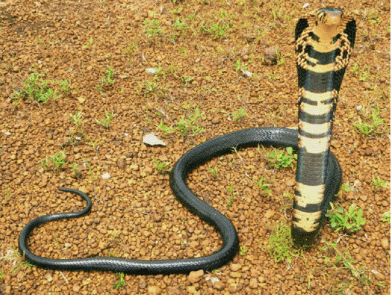
In the average British forest, the biggest risk is slipping in your wellies and getting mud all over your new jeans. African townsfolk have a different problem: the cunning forest cobra. This is a species of western and central Africa, with a powerful venom that mixes neurotoxins and cytotoxins.
Forest cobras love the woods, with their winding paths, secret hollows and thick beds of leaves which they find easy to move across. However, they’re less fond of human beings. Forest cobras won’t hesitate to rear up and lunge at anyone they decide is an intruder. Enter their forest domain and nobody is exempt, from local kids and beekeepers, to Boko Haram soldiers and western scientists.
Entering a forest in these parts is an in-out operation, the goal being to spend the shortest time in their midst as possible, and minimise the chances of a mad cobra charging at you from 50 metres away. You might get lucky or you might not, as it’s difficult to tell exactly where a forest cobra will be. They could be waiting 10 metres away, or they could be on the complete opposite side of the forest to you. Forest cobras are a fast, active species which gets around a lot.
Forest cobras aren’t contained within forests (this island is full of them), but they’re easily their headquarters. In grasslands or farmyards, their natural powers might be diminished somewhat, like a weaker echo of their normal ferocious self.
| 2 | Boddaert’s tropical racer |
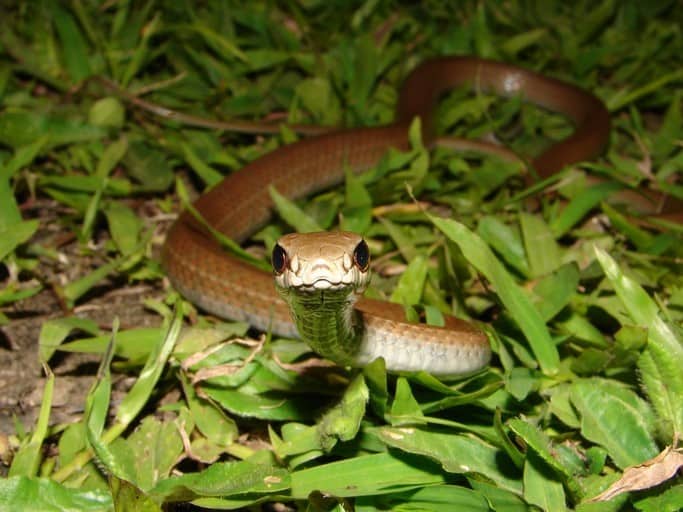
A snake which dwells in forests both local and remote. Boddaert’s tropical racer (Mastigodryas boddaerti) reaches lengths of 109cm, and primarily feeds on lizards. This is another snake that can reach large numbers, particularly in the deeper, darker inner sections of forests. Like its Miranda green racer relative, it’s a fast, manic snake when it gets going.
It can be hard to tell that Boddaert’s tropical racers are around until you’re some way down a forest trail. This is a classic snake where a pair of orange eyes pops up to your right, staring at you from the undergrowth, followed by another on your left, then another, and another, until suddenly, there’s 20 pairs of eyes watching you silently as you creep forward uncertainly. Boddaert’s tropical racer is actually a harmless snake (slightly venomous), but it takes a brave person not to fly into a panic.
Mastigodryas boddaerti is a snake which forages directly, charging after prey on their branches and subduing them with a chewing of mild venom. They sometimes bite, but this is a last resort after fleeing, thrashing, vibrating their tail, and detaching their tail.
| 3 | Scarlet snake |
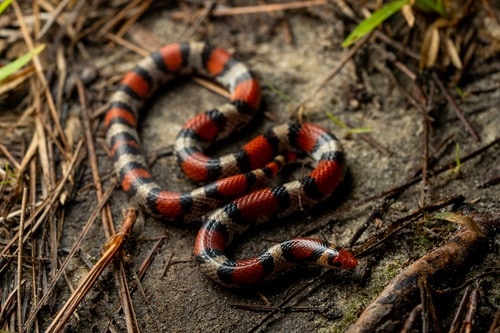
This non-venomous forest dweller could easily live close to your home in Florida or Georgia. The scarlet snake is a shy species which mainly lives in burrows dug out of soft soil. Reptile enthusiasts spend years trying to find this forest snake, only to fail miserably. You can look under every mulchy leaf pile and rotting tree log and find none, even after 100 cumulative hours. Meanwhile, a dog walker who stomps down the same woodland path every day will probably meet them once or twice, with no idea what he’s looking at.
Scarlet snakes inhabit a variety of forests, including damp hardwoods, sparse flatwoods, and coniferous forests. Their forests can be located alongside a road, or bordered by a football pitch; as long as a decent clump is standing, scarlet snakes can cling on.
Scarlet snakes mostly feed on lizards, and have a taste for turtle eggs, which they pierce with a specially shaped tooth. If you’re lucky, this species could be a 1 minute walk from your house. Getting a towel and sitting cross-legged on the forest floor for hours is probably the best way to find them.
| 4 | Large-eyed pitviper |
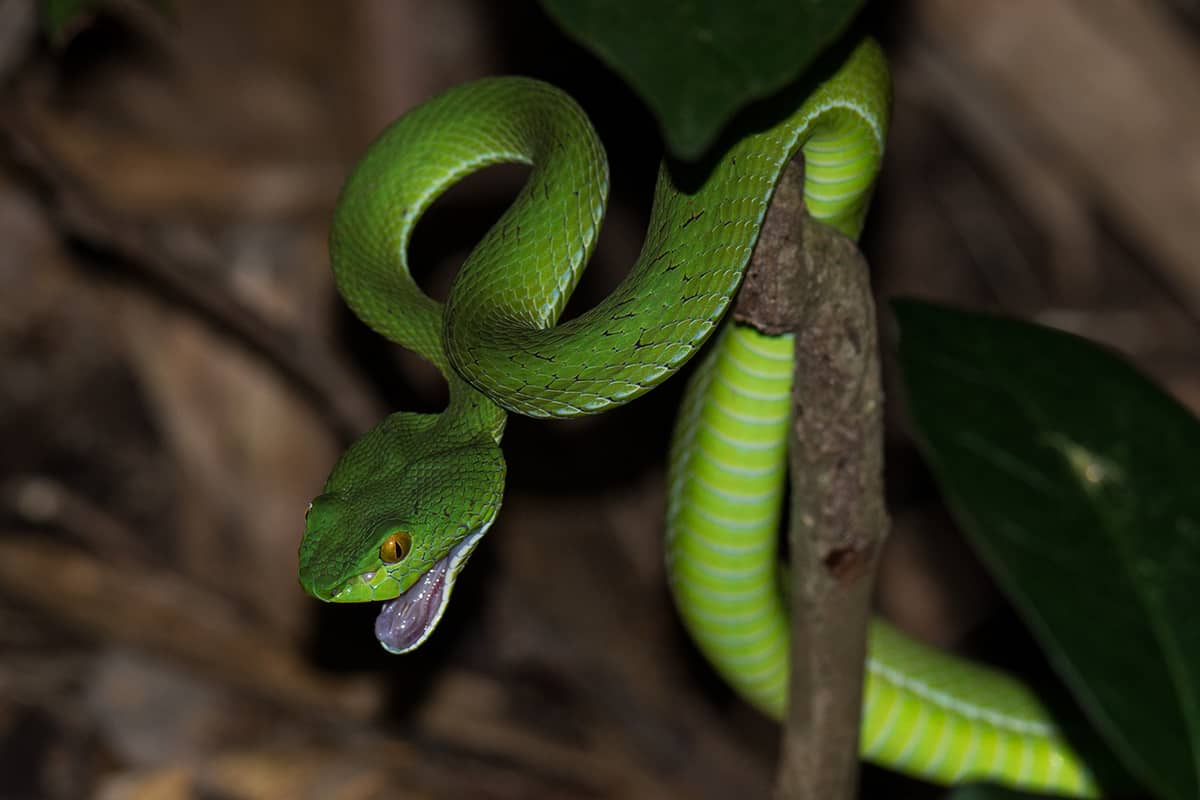
A 50-70cm snake of Thailand, with a cytotoxic, skin-shredding venom. Large-eyed pitvipers are part of the vast Trimeresurus family, which are almost all extremely green, but with subtle differences which you can pick out with a sprinkling of expert knowledge. The classic sign with this species is large eyes, a red tail, and a fainter white lip line than others.
Large-eyed pitvipers (Trimeresurus macrops) like forests, but cope well with human disturbed areas. With this snake, the priority is to remember an instinct that humans naturally forget: look up! Trimeresurus macrops is rarely found on the forest floor, preferring branch perches 1-3 metres above ground, which it rests on for most of the day, glaring at passersby menacingly. Many don’t notice this species, but others spot the snake, and freeze so solid, petrified, that the snake seizes its chance.
Even the simplest walk through the forest can end with a pitviper falling on your head, just as it can end with a heartwarming Bambi encounter. The extreme greenness is specifically designed to keep this family invisible in forests. Although most local Thai folks don’t know the exact species of this snake, they certainly know that “green vipers” are a menace to be avoided at all costs, as are the dark woods containing them. Large-eyed pitvipers can even appear in forest clumps in inner city Bangkok – this is no remote mountain snake.
| 5 | Grenada tree boa |
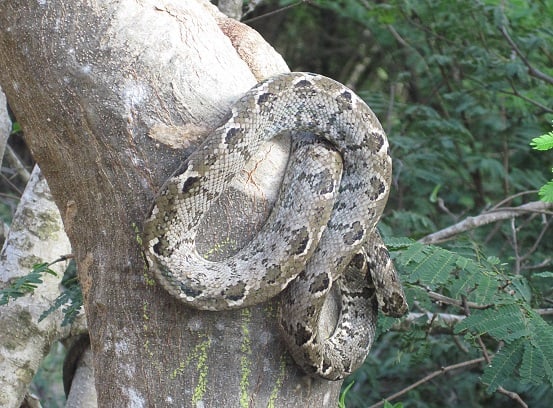
Found exclusively on Grenada, this is a tree-loving snake which belongs to the same Corallus family as the emerald tree boa. The difference is that Grenada tree boas actually prefer disturbed forests near villages, compared to remote untouched rainforests.
Grenada tree boas are an ambush snake as adults, but they’re not shy in the slightest. They prefer to rest casually on a tree branch 2-5 metres high, with a smile on their face, waiting for rodents. Grenada tree boas are unbelievably easy to find – just park your car and walk for about 30 seconds into the local woods. It’s estimated that they’re more common now than in pre-Columbus times (late 1400s), because of the growth of settlements.
Grenada tree boas are particularly addicted to rodents, which flock to feed on juicy fruit. Consequently, a spacious wood next to a busy fruit plantation is their absolute favourite spot.
Grenada tree boas can be extremely abundant, researchers have found 30 in one hour close to Beausejour and Pearls. They’re so common that most superstition has worn off, with locals realising the woods hosting them are perfectly safe, if unnerving.
| 6 | Black-headed snake |
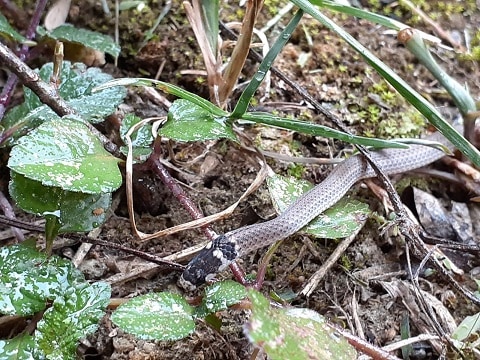
A snake heavily concentrated in the forests of southeast Brazil, where it enjoys a diet consisting of centipedes. This is a patient forest species, which is largely underground dwelling, and lurks under rotting logs and leaves when they do reach the surface. Black-headed snakes are mildly venomous and take 2-7 minutes to arrange a centipede before finally swallowing, which is always headfirst. Black-headed snakes (Tantilla melanocephala) also face battles of their own, becoming stuck in the webs of greedy brown widows, and being swooped down on by burrowing owls. All this can be happening a couple of hundred metres from the family kitchen, where parents and kids sit eating chicken for dinner.
This snake sticks to the ground rather than in branches, so if anything happens, it’ll be accidentally stepping on it. They’re pretty hard to miss, with a fleshy red body (sometimes grey) contrasting against a black face like a masquerade mask.
Nevertheless, the most snake-infested forest can be strangely quiet one day, when it’s usually a nightmare. It could be the spring lazy season, or an especially hot day which forces the local snakes underground. The black-headed snake is one such snake that prefers certain conditions, being most common after heavy rains. After a week of baking sun, the forest will be empty, as they’ll be lurking in former mammal burrows, or miniscule soil tunnels of their own making.
| 7 | Mamushi |
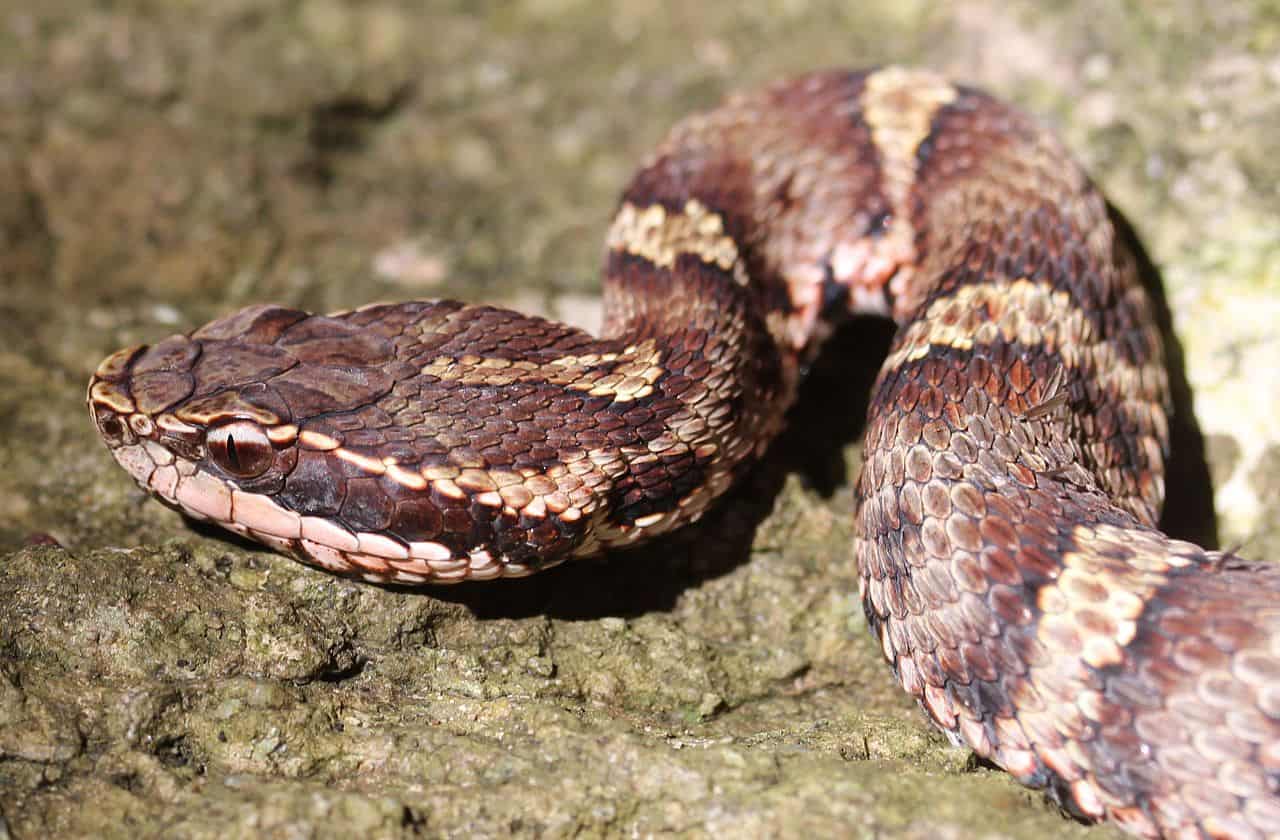
The mamushi is the main venomous snake of Japanese forests, including those directly next to village paths. This is the snake parents constantly warn their children about when playing in the local woods. Its venom is a cocktail of nastiness, with a mixture of neurotoxins, hemotoxins and cytotoxins.
If a mamushi was offered any location in the world to live, it would still choose a mild forest with a thick bed of leaves. They rest beneath piles of those leaves, giving them incredible camouflage. The worst thing is that mamushis don’t move much, causing people to step on them accidentally.
Great fear surrounds this snake in Japanese villages, as it only takes one snakebite for a forest to get an evil reputation. As the frightful tale spreads among villagers, getting slightly more exaggerated with every retelling, the fact that the forest is a snake haven becomes undeniable, even though it probably contains no more snakes than anywhere else. Even a slight rustling in the bushes is assumed to be vicious pitviper, sending gangs of teenagers fleeing, who have usually sneaked in for a bet, against their parents wishes. Though the legends grow over time, there are undoubtedly numerous local forests where the mamushi is lurking, waiting.
| 8 | Painted bronzeback |
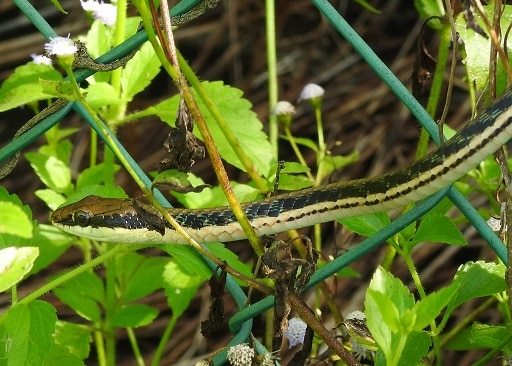
The painted bronzeback is a Southeast Asian snake, particularly inhabiting Thailand and peninsular Malaysia. Forests are their home, not just untouched rainforests, but disturbed forests at the edges of towns and villages, even with freshly cut piles of timber lying around.
When conditions are right, they can balloon to extremely high numbers. Your local woods could be swarming with them, but rest assured that this snake is completely harmless. They’re nothing more than a local woodland character, part of the scenery along with birds and squirrels. Even if they’re staring directly at you, rotating their head as you walk, it’s purely out of curiosity. The painted bronzeback would never dream of attacking a bird watcher, or even a lumberjack about to swing an axe at its tree.
Painted bronzebacks have lived in forests near humans for thousands of years, happily going about their lives and having no problem with people exploring their home. This is a proper forest snake; in an open field they’d probably curl up in panic, whereas in trees they dart effortlessly around like an acrobat. Painted bronzebacks average at 60cm and have a pale yellow belly. In the finely balanced forest ecosystem, this is one of the main lizard predators.
| 9 | Clark’s ground snake |
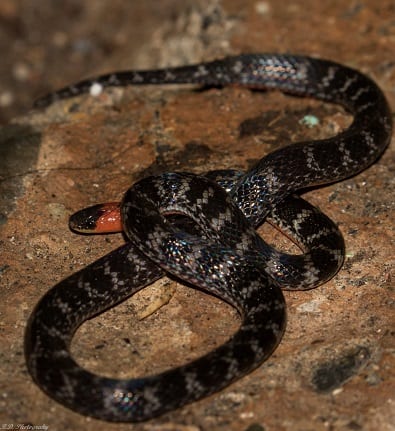
Another fossorial snake which is hard to find. Like the scarlet snake, a dedicated herpetologist could spend an entire year planning an expedition to find this species and fail miserably. The Atractus family are all underground lovers, and the family has 140 members. Atractus clarki sticks to Ecuador and Columbia. They have classic underground adaptions such as beady eyes and smooth scales to prevent dirt from building up.
Clark’s ground snakes feed on earthworms, and require soft floors to excavate, particularly forested mulch. They inhabit pristine forests, but also forests amid a patchwork of fields near rural houses.
The barriers to spotting this snake are immeasurable. Step 1 is to realise that Clark’s ground snake even exists, by reading an obscure corner of wikipedia. The second step is to wander the forest at precisely the right hour, when they’re exploring the surface and not lurking in their underground lairs. Next, you have to lay your eyes on the tiny, 30x30cm forest path where they’re lying. Finally, you need the visual sharpness to distinguish the Clark’s ground snake from nearby fallen twigs. If you live by a forest in Ecuador, your front porch could be 100 metres from a Clark’s ground snake colony and you might never meet one, or realise that they’re there.
| 10 | Radiated ratsnake |
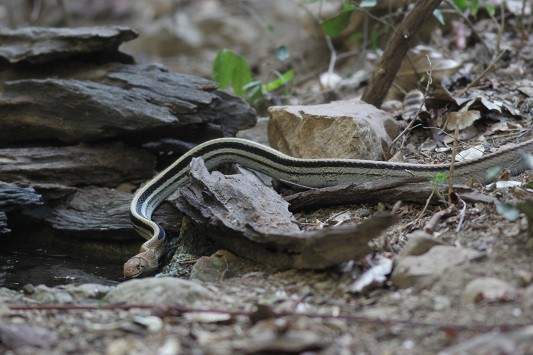
The radiated ratsnake is a constricting serpent of India, which lacks any form of venom and regularly reaches 170cm long. They can live in remote forest corners accompanied only by a lost hiker, but are equally common in forests bordering towns, and particularly those adjacent to village rice paddies. Radiated ratsnakes are a fast-moving snake, a classic one to make rustling sounds through the undergrowth which have you rotating worriedly on the spot. This is day-faring species, which are very easy to find, being so energetic.
Radiated ratsnakes dislike people entering their personal space and have a defensive personality. Despite the lack of venom, reptile handlers would still rather approach with steel snake tongs.
With this snake, there’s no need to stay up until midnight, lock your front door, and head into the forest under the glow of moonlight, while everyone else is sleeping. Just head to a rice paddy directly next to a forest, and your odds of finding a radiated ratsnake are great. The only worry is being ambushed by its mates, including Russell’s vipers in India, or Javan spitting cobras in Indonesia.
